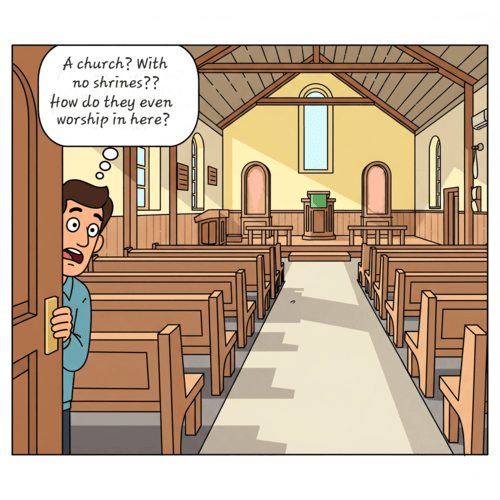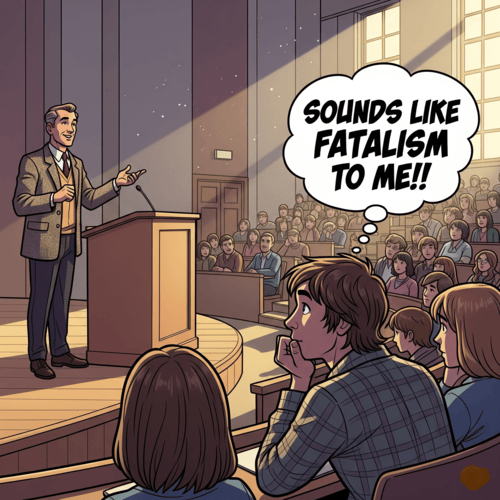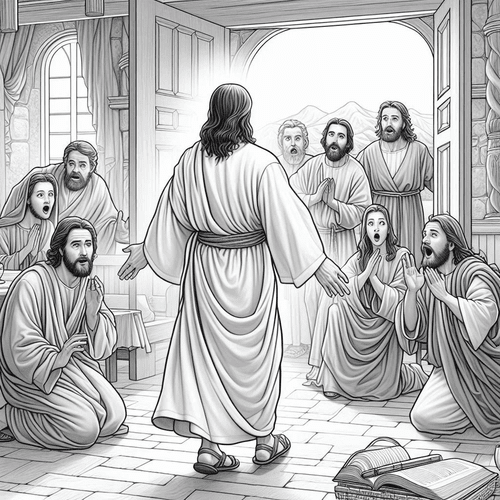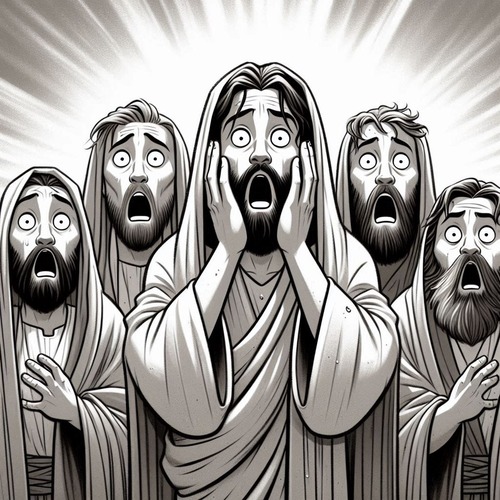Mass Hallucination: Does This Explain Resurrection Appearances?
The claim that Jesus rose from the dead is at the very heart of Christianity. Without it, as the Apostle Paul boldly stated, our faith would be “useless” (1 Corinthians 15:14). Yet many find it easier to believe Jesus’ followers experienced some form of collective hallucination rather than accept His return from the dead.
It’s a reasonable question to ask: Could grief-stricken followers, desperately hoping for their leader’s return, have simply imagined seeing him? Let’s examine the evidence and see whether mass hallucinations provide a satisfying explanation for what early Christians claimed to have witnessed.
UNDERSTANDING REAL HALLUCINATIONS
Before we can determine if hallucinations explore the resurrection appearances, we need to understand what hallucinations actually are. According to psychologists, hallucinations are false perceptions that appear real to the person experiencing them but have no basis in external reality.
Several key characteristics define genuine hallucinations:
- They’re individual experiences not collective ones. While people in groups may experience similar hallucinations due to shared substances or conditions, they don’t typically see the exact same thing at the same time.
- They typically occur in people predisposed to them through factors like sleep deprivation, drug use, mental illness, extreme stress, or certain neurological conditions.
- They reflect existing expectations and mental states. People hallucinate things aligned with their existing thoughts and expectations.
- They are rarely consistent across multiple instances, people, and settings.
With these characteristics in mind, let’s examine the biblical accounts of Jesus’ resurrection appearances.
THE RESURRECTION APPEARANCES: TOO VARIED FOR HALLUCINATIONS
The New Testament records numerous appearances of the risen Jesus, occurring under remarkably different circumstances:
- To Mary Magdalene alone in the garden (John 20:11-18)
- To two disciples on the road to Emmaus (Luke 24:13-35)
- To ten apostles in a locked room (John 20:19-23)
- To eleven apostles a week later, including Thomas (John 20:24-29)
- To seven disciples while fishing (John 21:1-14)
- To all the apostles at his ascension (Acts 1:4-9)
- To more than 500 people at once (1 Corinthians 15:6)
- To James, Jesus’ sceptical brother (1 Corinthians 15:7)
- To Paul, an active persecutor of Christians (Acts 9:1-9)
These appearances occurred over 40 days, in different locations (Jerusalem, Galilee, the road to Emmaus), to different people (individuals, small groups, large crowds), and under different circumstances (indoors, outdoors, morning, evening).
WHY MASS HALLUCINATIONS FALL SHORT
When we compare what we know about hallucinations with the resurrection accounts, several problems emerge:
Different People, Different Places: Hallucinations don’t spread like viruses. The disciples weren’t all in the same emotional state or environment when they claimed to see Jesus. Some were walking, others fishing, others hiding behind locked doors. If these were hallucinations, why were they so consistent across diverse settings and emotional states?
Physical Interactions: The risen Jesus wasn’t just seen; he was touched and ate food with his followers. In Luke 24:41-43, Jesus asks for food and eats it to prove he isn’t a ghost. Thomas is invited to touch Jesus’ wounds (John 20:27). Hallucinations don’t leave physical evidence or interact with the material world.
Unexpected Appearances: In many cases, Jesus wasn’t immediately recognized or wasn’t who they expected to see. Mary Magdalene mistook him for a gardener. The Emmaus disciples walked with him for hours before recognizing him. If these were projections of wishful thinking, why didn’t they immediately recognize the person they longed to see?
Sceptics and Enemies Convinced: Perhaps most compelling is that Jesus appeared to people who weren’t disposed to hallucinate him. James, Jesus’ brother, was sceptical during Jesus’ ministry (Mark 3:21, John 7:5) yet became a church leader after witnessing the resurrected Jesus. Paul was actively persecuting Christians when he encountered the risen Christ. These aren’t the psychological profiles of people predisposed to hallucinate Jesus’ return.
The Group of 500+: Paul mentions Jesus appeared to more than 500 people at once (1 Corinthians 15:6), many of who were still alive when Paul was writing. This scale simply doesn’t align with what we know about hallucinations. No documented case of mass hallucination involves hundreds of people simultaneously having the exact same detailed experience.
THE EMPTY TOMB PROBLEM
The hallucination theory also fails to explain the empty tomb. Both Jewish and Roman authorities had strong motives to produce Jesus’ body and end the resurrection claims. They never did. If Jesus’ followers were merely hallucinating, his body would still have been in the tomb.
Jewish authorities instead claimed the disciples stole the body (Matthew 28:11-15)—an implicit admission the tomb was indeed empty. Why create this explanation if they could simply produce the body?
THE TRANSFORMED LIVES PROBLEM
Perhaps the most persuasive evidence against the hallucination theory is what happened next. The disciples were transformed from fearful followers hiding behind locked doors to bold proclaimers willing to face persecution and death. All but one of the apostles died for their testimony.
People might die for what they mistakenly believe to be true, but these disciples were in a position to know whether they had genuinely seen Jesus or merely hallucinated him. Would they all maintain this claim under threat of execution if they knew it was just a collective delusion?
CONCLUSION: MASS HALLUCINATION
When we carefully examine the historical evidence, the mass hallucination theory requires more faith than believing in the resurrection itself. It requires us to believe that:
- Multiple groups of people experienced identical hallucinations
- These hallucinations included physical interactions
- Sceptics and enemies somehow shared in these hallucinations
- The hallucinations transformed people’s lives so completely they were willing to die for them
- Nobody ever recanted despite increasing persecution
- And somehow, Jesus’ body went missing at the same time
The simplest explanation that accounts for all the evidence is that what the early Christians claimed actually happened: Jesus rose bodily from the dead. This explanation requires only one miracle rather than a series of highly improbable psychological events affecting hundreds of people across different times and locations.
If Jesus really did conquer death, the implications are profound. It means his claims about himself deserve our attention. It means death isn’t the end. And it means hope is built on something far more substantial than wishful thinking.
MASS HALLUCINATION: RELATED FAQs
Could the disciples have experienced grief hallucinations? Grief hallucinations typically involve brief, sensory experiences of the deceased person in familiar settings—not extended conversations and physical interactions across different locations. Moreover, grief hallucinations usually occur to individuals, not groups, and typically fade within weeks, whereas the disciples’ encounters happened to multiple people and fundamentally changed their beliefs and behaviours for the rest of their lives.
- What about modern cases of mass hysteria or shared visions? Modern cases of mass hysteria typically involve ambiguous sensory experiences (strange sounds, vague visual phenomena) or shared physical symptoms—not detailed, interactive encounters with a specific person. Additionally, these cases usually occur among people already primed to expect something unusual and in the same location at the same time, unlike Jesus’ appearances which happened across different times, places, and to people in different mental states.
- Couldn’t the resurrection stories have evolved over time into more spectacular accounts? The earliest Christian creed mentioning the resurrection appearances (1 Corinthians 15:3-8) dates to within 3-5 years of Jesus’ death, too early for significant legendary development. Paul specifically mentions numerous eyewitnesses still alive who could verify these accounts, a risky move if he were embellishing the facts. The core elements of bodily resurrection appearances to individuals and groups remain consistent across all early Christian sources.
Why didn’t Jesus appear to the Roman or Jewish authorities if he wanted to prove his resurrection? The resurrection appearances weren’t primarily about providing proof but about commissioning Jesus’ followers to continue his mission. Throughout biblical history, God rarely offers overwhelming proof that removes the need for faith but provides sufficient evidence for those willing to believe. Jesus himself suggested in the parable of the rich man and Lazarus that those unwilling to believe Moses and the prophets “will not be convinced even if someone rises from the dead” (Luke 16:31).
- How do we know the Gospel writers didn’t simply invent the resurrection appearances? The Gospel accounts contain details that would be counterproductive if invented, such as women being the first witnesses (women’s testimony was not highly valued in that culture) and the disciples’ initial disbelief and confusion. Multiple independent sources report the resurrection, and the early church’s willingness to die for this claim suggests they genuinely believed they had witnessed the risen Jesus rather than perpetuating a story they knew to be false.
- Could the disciples have experienced vision-inducing substances or food? There’s no historical evidence suggesting the disciples consumed hallucinogenic substances, and such an explanation would still fail to account for the empty tomb, the coordinated nature of their experiences, and the appearances to sceptics like James and enemies like Paul. Furthermore, hallucinogenic experiences tend to be highly subjective and varied between individuals, not producing the consistent testimony about Jesus that emerged from diverse witnesses.
Why don’t we see resurrection appearances continuing today if they were real? The biblical accounts present the resurrection appearances as a specific, time-limited phenomenon that occurred over 40 days before Jesus’ ascension. These appearances served a foundational purpose in establishing the apostolic witness that would form the basis of Christian faith for future generations. Christians today believe Jesus continues to be present through the Holy Spirit and will return physically in the future, but the specific form of resurrection appearances described in the New Testament represented a unique historical moment.
MASS HALLUCINATION: OUR RELATED POSTS
Editor's Pick

Do Christians Need Holy Shrines? Why the Reformed Answer Is No
Walk into a medieval cathedral and you'll encounter ornate shrines, gilded reliquaries, and designated "holy places" where pilgrims gather to [...]

I Want To Believe, But Can’t: What Do I Do?
"I want to believe in God. I really do. But I just can't seem to make it happen. I've tried [...]

BC 1446 or 1250: When Did the Exodus Really Happen?
WHY REFORMED SCHOLARS SUPPORT THE EARLY DATE Many a critic makes the claim: “Archaeology has disproven the biblical account [...]

Does God Know the Future? All of It, Perfectly?
Think about this: our prayers tell on us. Every time we ask God for something, we’re confessing—often without realising it—what [...]

Can Christian Couples Choose Permanent Birth Control?
Consider Sarah, whose fourth pregnancy nearly killed her due to severe pre-eclampsia, leaving her hospitalised for months. Or David and [...]

Bone of My Bones: Why Eve Was Created From Adam’s Body
"This at last is bone of my bones and flesh of my flesh!" Adam's joyful exclamation upon first seeing Eve [...]

Is Calvinism Fatalism in Christian Disguise? Think Again
We hear the taunt every now and then: "Calvinism is just fatalism dressed up in Christian jargon." Critics argue Reformed [...]

Can Churches Conduct Same-Sex Weddings?
In an era of rapid cultural change, churches across America face mounting pressure to redefine their understanding of marriage. As [...]

Gender Reassignment: Can Christian Doctors Perform These Surgeries?
In the quiet of a clinic, a Christian physician faces a challenging ethical question. A patient sits across the desk, [...]

‘What Sorrow Awaits You Who Are Rich…’: What Does Jesus Mean?
The words hang in the air like a sword over comfortable Christianity: “What sorrow awaits you who are rich, for [...]
SUPPORT US:
Feel the Holy Spirit's gentle nudge to partner with us?
Donate Online:
Account Name: TRUTHS TO DIE FOR FOUNDATION
Account Number: 10243565459
Bank IFSC: IDFB0043391
Bank Name: IDFC FIRST BANK






